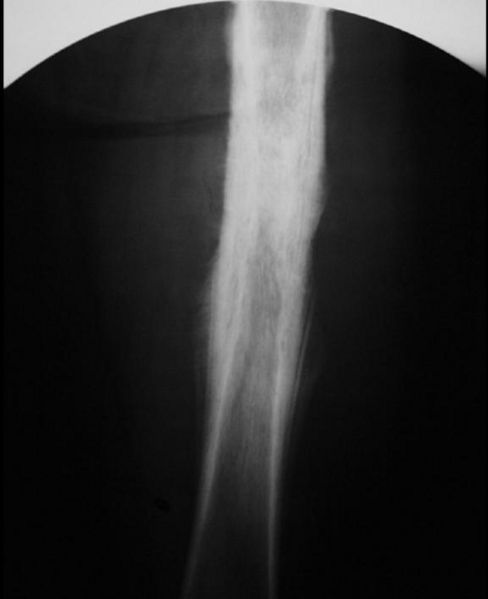Ewing's sarcoma x ray: Difference between revisions
Jump to navigation
Jump to search
(→Images) |
(→Images) |
||
| Line 4: | Line 4: | ||
==Overview== | ==Overview== | ||
Chest X-ray and chest CT scan: This plain x-ray and CT scan of your chest may be done to see if the cancer has spread to your lungs. | Chest X-ray and chest CT scan: This plain x-ray and CT scan of your chest may be done to see if the cancer has spread to your lungs. | ||
==Images== | ==Images== | ||
* Both long and flat bones are affected. | |||
* In the long bones, the tumor is almost always metaphyseal or diaphyseal. | |||
* Most commonly, radiographs show a long, permeative lytic lesion in the metadiaphysis and diaphysis of the bone with a prominent soft tissue mass extending from the bone. | |||
* Periosteal reaction usually is present, and it often has an '''onionskin or sunburst pattern''', which indicates an aggressive process. | |||
* In some patients, Codman triangles may be present at the margins of the lesion. These result from the elevation of the periosteum and central destruction of the periosteal reaction caused by the tumor. | |||
<gallery> | <gallery> | ||
EwingSarcomaTibia.jpg|X-Ray of a child with Ewing's sarcoma of the tibia | EwingSarcomaTibia.jpg|X-Ray of a child with Ewing's sarcoma of the tibia | ||
Revision as of 16:30, 3 August 2012
|
Ewing's sarcoma Microchapters |
|
Diagnosis |
|---|
|
Treatment |
|
Case Studies |
|
Ewing's sarcoma x ray On the Web |
|
American Roentgen Ray Society Images of Ewing's sarcoma x ray |
Editor-In-Chief: C. Michael Gibson, M.S., M.D. [1]; Assistant Editor(s)-In-Chief: Michael Maddaleni, B.S.
Overview
Chest X-ray and chest CT scan: This plain x-ray and CT scan of your chest may be done to see if the cancer has spread to your lungs.
Images
- Both long and flat bones are affected.
- In the long bones, the tumor is almost always metaphyseal or diaphyseal.
- Most commonly, radiographs show a long, permeative lytic lesion in the metadiaphysis and diaphysis of the bone with a prominent soft tissue mass extending from the bone.
- Periosteal reaction usually is present, and it often has an onionskin or sunburst pattern, which indicates an aggressive process.
- In some patients, Codman triangles may be present at the margins of the lesion. These result from the elevation of the periosteum and central destruction of the periosteal reaction caused by the tumor.
-
X-Ray of a child with Ewing's sarcoma of the tibia
-
Radiograph demonstrates classic sunburst pattern of periosteal reaction.
